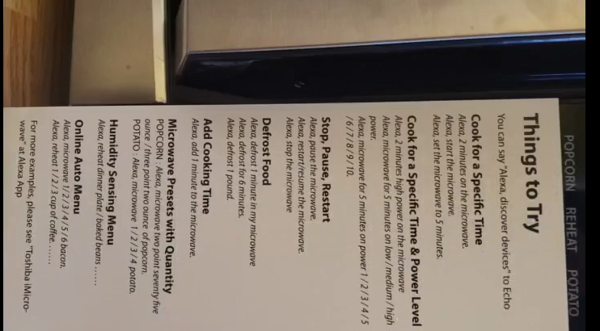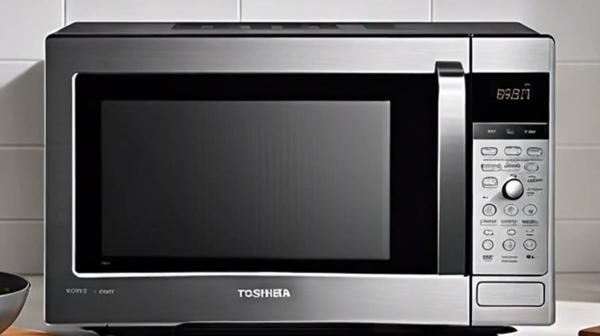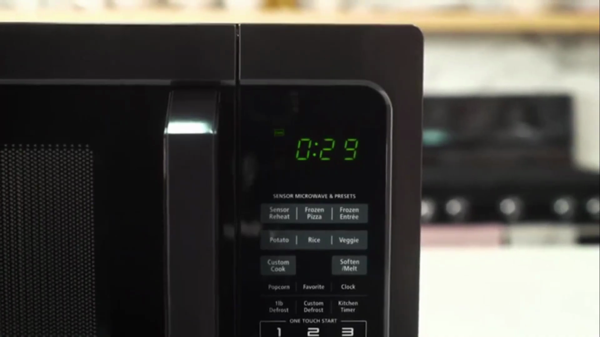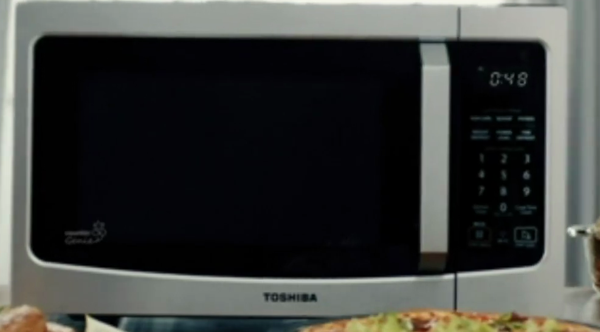Note: As an Amazon Associate I earn from qualifying purchases.
My experience with the TOSHIBA ML-EM34P(SS) Smart Microwave: Stainless steel and compatible with Alexa (2024)
Introduction
I recently purchased a smart Toshiba microwave (the TOSHIBA ML-EM34P(SS) to be price, with handy Alexa control). As an advocate for smart home devices and someone who values minimalism in my living space, it looked like a great device to me. With hands-free operation and a modern look, this microwave seemed to offer the best of both worlds: ease and efficiency for my kitchen. Below is my experience with it.
Specifications
| Property | Value | Property | Value |
|---|---|---|---|
| Brand | Toshiba | Product Dimensions | 16.6”D x 20.4”W x 12.4”H |
| Color | Stainless Steel | Capacity | 1.3 Cubic Feet |
| Special Feature | Humidity sensor, ECO+Mute, Microwave Works with Alexa | Recommended Uses For Product | Vegetable |
| Installation Type | Countertop | Wattage | 1100 watts |
| Material | Stainless Steel | Included Components | Turntable^1, 1 Microwave Oven^1 Manual Instruction Book^1 Turntable plate |
Photos
Click on photos to enlarge them:
Prices
Check prices of the TOSHIBA ML-EM34P(SS) Smart Microwave, Stainless Steel, Alexa-Compatible on:
Smart Features Overview
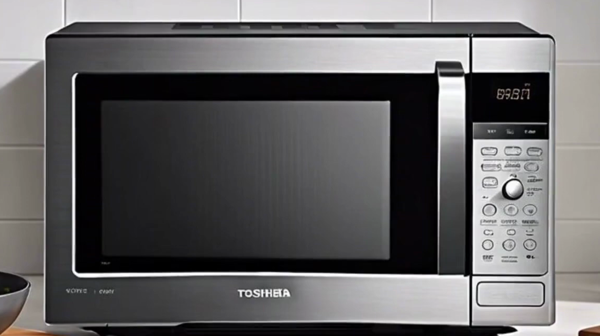
The Toshiba 1.3 Cubic feet 1100-watt Black Stainless Steel microwave with Alexa compatibility piqued my interest due to its modern design and advertised smart capabilities. As a person who appreciates the ease of use of smart home devices, I was drawn to the idea of a microwave that could be controlled hands-free. The hands-free operation is particularly appealing in a busy kitchen as it enhances multitasking efficiency.
Hands-free voice control with Alexa: A true kitchen helper, allowing me to command the microwave while prepping other ingredients.
Voice control is convenient for preparing snacks like popcorn or reheating food such as pizza without pressing buttons.
Sensor reheating technology adjusts cooking power automatically for even heating, providing reassurance.
But for the convenience it offers, using the device with Alexa integration comes with challenges. The connection can switch from smooth operation to unresponsiveness unexpectedly, requiring me to revert to manual control. These issues disrupt the smart home experience I sought, so addressing them is essential.
Another downside is that the app connectivity and 23 preset menus may not function properly if there are issues with the app or smartphone, making some features inaccessible and frustrating to use.
Moreover, I’ve encountered issues with the touch panel’s visibility in low light conditions. This is a design flaw that could be addressed by adding a backlit keypad to enhance accessibility and uphold the appliance’s user-friendly reputation.
When using the ECO Mode feature, I save energy efficiently. This setting reduces power consumption when the microwave is inactive, aligning with my eco-friendly habits.
In sum, this microwave showcases modern convenience with some challenges in smart home technology integration. If you’re fond of voice-activated gadgets and can handle occasional tech hiccups, I’d recommend it. But if you prefer simple and dependable appliances without such issues, this might not be the best choice.
Cooking Performance Evaluation

Evaluating the cooking performance of the Toshiba microwave with Alexa compatibility, I found that its functionality can be impressively versatile, making it a suitable companion for the kitchen. Here’s my breakdown:
Positives:
1100 watts of power is sufficient for most microwave tasks.
The humidity sensor regulates cooking power, preventing food from burning or being undercooked.
The six pre-programmed sensor menus are useful for typical items. Adding up to 23 preset menus through the app increases convenience. These pre-programmed menus can be easily customized and saved for future use, providing even more functionality and efficiency.
The multi-stage cooking feature is beneficial for intricate recipes due to its ability to incorporate various cooking modes.
Drawbacks:
Some pre-packaged foods suggest a 1200-watt microwave for heating, which requires adjusting cooking times if you’re using a 1100-watt appliance.
The keypad isn’t lit from behind, making it difficult to use in dim environments.
The microwave effectively handles various tasks from reheating leftovers to cooking complex dishes. Its sensor reheating feature is notable, making it easy to reheat meals without overdrying or leaving cold spots. Additionally, its air fryer capability is a significant advantage, offering a healthier option for fried foods without requiring an additional appliance.
That said, the air fryer feature in the appliance has resulted in uneven cooking on occasion. This issue is most noticeable when following instructions intended for a conventional air fryer. However, with some experimentation, it can be resolved.
The ECO mode is a beneficial feature for those mindful of energy consumption. It can save up to 50% of standby energy, according to the manufacturer, which is financially wise and eco-friendly. This energy savings doesn’t compromise cooking effectiveness.
In terms of clarity, the manual could provide more information, given the microwave’s multiple functions. New users of combo appliances might feel confused at first.
Overall, the Toshiba microwave provides a good balance between basic microwave functions and advanced cooking features. This demonstrates the progress of smart kitchen appliances, such as the Smart SHARP IoT Microwave Drawer, enabling users to control it via voice command or app integration into a modern home automation system. While there are some minor issues like the non-backlit keypad, these drawbacks are outweighed by its versatility and convenience.
Design and Usability Thoughts

When I bought my Toshiba microwave, with its black stainless steel design and compact size, it instantly caught my eye in the crowded appliance store. Its sturdy door handle and sleek appearance were a huge plus for my kitchen’s limited counter space. However, what truly sets this device apart is its smart capabilities and compatibility with Alexa. The ability to microwave, convection bake, and air fry in one compact device, all controlled by voice commands or the touch screen, was a significant advantage, given the scarcity of kitchen space in my apartment. This huge plus feature has made my cooking experience more convenient and efficient.
Design Pros:
Sleek and modern look
Intuitive control panel
Use a handle instead of a push-button to open doors.
Suitable for small spaces with a compact design.
Design Cons:
In low light conditions, the non-backlit keypad is hard to see.
The air fry function didn’t deliver satisfying results for certain dishes.
The cooking modes enhance my daily routine, and I frequently use the sensor reheating feature for preventing leftovers from drying out. The mute function is beneficial for me as a night owl who often heats up snacks late at night while others sleep.
Now, I noticed some minor design issues. The control panel isn’t backlit which can be problematic when heating up a late-night snack in the dark. The instructions are straightforward but lack sufficient detail for those new to combo units.
I also had some thoughts about the air fryer function. It takes longer than stated on food packaging, and it doesn’t fully replace a standalone air fryer. Preparation requires some experimentation.
The smart capabilities of the device were what initially drew me to purchase it. In particular, the voice commands using Alexa have proven to be very convenient and efficient when the connection is stable. However, my experience has been inconsistent as I’ve encountered Wi-Fi connectivity issues that hinder the full expression of this smart capability. It can be quite frustrating to rely on a product’s smart capabilities for added convenience only to experience microwave functionality on days with unstable Wi-Fi connections.
I’m glad I chose a well-made product when I purchased this microwave, which has become a testament to modern convenience in my home. It has significantly enhanced my setup, facilitating multitasking in my busy life, but I must admit that it occasionally experiences a technological hiccup. This well-built device is an embodiment of technological advancements, making my life easier and more efficient. However, be mindful that while it’s a future-ready testament to modern convenience, it may encounter the occasional technological issue.
Smart Home Integration Challenges

Incorporating smart home technology into my kitchen with the Toshiba Alexa-Compatible Microwave was an enlightening experience. The appeal of minimalism and streamlined functionality aligns with the contemporary preference for efficient and clutter-free living spaces.
Here are some of the key takeaways:
Using Alexa for voice commands simplifies cooking processes.
App integration plays a significant role in bringing ease with pre-set menus and adjustable sensor settings when integrating apps.
The ECO mode button saves energy.
Hands-free operation is beneficial for individuals with mobility issues.
However, the integration of smart home technology hasn’t been perfect. At first, I was excited about using voice commands for tasks like reheating leftovers or making popcorn. When these voice commands worked through Alexa, it was a wonderful experience. But when they didn’t, it caused frustration.
The microwave’s inability to connect and respond to Alexa commands is a common issue reported by users. Despite a good start, this problem arises even when the Wi-Fi connection is strong and no changes have been made to the setup. Some users have noted that after updates, their microwaves no longer respond to Alexa at all. The microwave functions well on its own, but the promised smart integration through Alexa is not consistently reliable, resulting in frustration for many users.
Although the ECO mode saves energy, I’m disappointed that it doesn’t have a backlit keypad. Manually operating it in the dark requires extra lighting, which goes against energy efficiency. Additionally, integration issues with Alexa make manual operation necessary, contradicting the concept of a smart home.
In conclusion, the Toshiba Microwave’s smart home features are suited for minimalist and efficient homes. However, integration issues indicate that this technology is still developing. It offers benefits but requires improvement to become essential in a fully-realized smart home. Until connectivity problems are addressed, buyers must consider their need for dependability versus the allure of advanced features.
